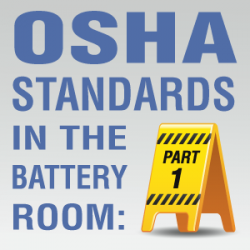We use cookies to make your experience better. To comply with the new e-Privacy directive, we need to ask for your consent to set the cookies. Learn more.
OSHA Standards in the Battery Room — Part One: Introduction to OSHA Regulations

Are you using lift trucks safely? Warehousing operations in the United States are legally bound to protect workers from unsafe conditions, as defined by The Occupational Safety and Health Administration (OSHA).
While OSHA standards dictate workplace safety practices in all aspects of the warehousing industry, few areas are more impacted by these safety regulations than the battery room. Oversights in the battery room can easily lead to worker injuries -- not to mention property damage -- and every dollar spent on safety is a wise investment.
This series of posts will provide a quick introduction to OSHA standards that apply to forklift batteries and battery handling equipment. In part one, we’ll introduce the standards and interpretations that allow for full OSHA compliance in all forklift battery handling tasks.
In the next few posts, we will provide practical guides to the OSHA standards that are most relevant to battery handling procedures, including change-outs, charging, and storage. Relevant OSHA standards include:
- 29 CFR 1910.132 - Personal Protective Equipment.
- 29 CFR 1910.133 - Eye and face protection.
- 29 CFR 1910.151 - Medical services and first aid.
- 29 CFR 1910.157 - Portable fire extinguishers.
- 29 CFR 1910.178(g) - Changing and charging storage batteries.
- 29 CFR 1910.305(j)(7) - Storage Batteries.
- 29 CFR 1926.441 - Batteries and battery charging.
First, a quick but important caveat: as in any situation that involves the Code of Federal Regulations, specific questions or concerns should be addressed to a trained legal professional. This article is intended as a general guideline -- not as operating advice or legal advice.
For in-depth assistance with OSHA compliance, contact your local OSHA consultation office.
Which OSHA Standards Apply to Your Battery Room?
In general, OSHA standards are organized by industry. The vast majority of enterprises fall into one of four categories:
- General Industry (Part 1910)
- Maritime (Parts 1915, 1917, and 1918)
- Construction (Part 1926)
- Agriculture (Part 1928)
Battery handling standards can be found in Parts 1910, 1917, and 1926, but unfortunately, applying industry-specific standards alone is not necessarily enough to maintain proper compliance. In some cases, multiple standards apply.
For instance, OSHA’s interpretation of the standards 29 CFR 1910 and 29 CFR 1926 states that “in most instances, either or both sets of standards can be expected to be applicable. . . “ This wording allows for any possible combinations of the two sets of standards. Fortunately, the letter of interpretation goes on to provide some clarity; the General Industry standards found in 29 CFR 1910 should be applied in all workplaces unless an industry-specific regulation specifically takes precedence.
Understanding OSHA Regulations for Battery Handling Tasks
Because of the general nature of 29 CFR 1910, the battery handling regulations found in that section are the most important for most warehouses and distribution centers. Part 1926 of the OSHA standards covers battery handling specifically for electric industrial equipment in the construction industry.
Because some of the regulations found in Part 1926 provide more detail than those found in Part 1910, many warehouse managers also consult these standards when planning battery room layout and charging procedures. Forklift battery charging procedures in construction applications are governed by Part 1926 of the OSHA regulations, with Part 1910 filling any gaps.
This series will not cover the regulations contained in Part 1917; they are specific to maritime industries, and rarely depart from the guidelines set forth in Parts 1910 and 1926 of the Code. To learn more about OSHA requirements for battery handling in maritime applications, consult OSHA standard 1917.157.
In the next entry in this series on OSHA in the battery room, we will provide a simple guide to the battery handling standards from the General Industry section of the Code, Part 1910.
References:
Eckhardt, Bob. "Sorting Out Battery Handling Regulations."Concrete Products 103.7 (2000): 96. Business Source Premier. Web. 14 May 2015.
"No Eye Wash Station: No Hazard?." Safety Management 480 (2003): 4. Business Source Premier. Web. 14 May 2015.
